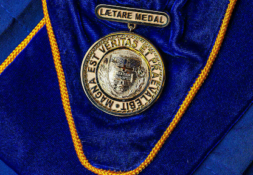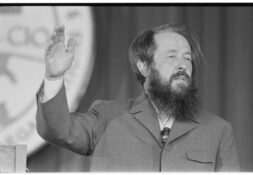Exploring the science of mystery
“A Conversation With Lisa Randall,” presented by the Multicultural Student Building Bridges Mentoring Program and the College of Science IBM Corporate Lectureship, was just that: a conversation. Professor Lisa Randall, the Frank B. Baird Jr. Professor of Science at Harvard University, visited Notre Dame to present her book, Dark Matter and the Dinosaurs, on Monday, September 25.
Dark Matter and the Dinosaurs, a New York Times Bestseller, explores connections between various fields of science, speculating on the possibility that dark matter is a manner in which unseen forces can impact the course of history. She argues that dark matter could have caused the asteroid which wiped out the dinosaurs to strike Earth, dramatically altering the evolutionary path of our planet. The book is designed to be easily accessible to the public, regardless of background in theoretical physics.
Randall sat across from Notre Dame Nuclear Physics Professor Ani Aprahamian, who initially asked Randall what, if anything, motivates her. She answered, “Physics is very abstract. If no one communicates it, then no one will understand it.”
Randall continued to share her perspective on the sciences. She likened the process of scientific communication to this: “Imagine a story about living in a two dimensional world, and how hard it would be for the characters to imagine a three dimensional world. A different story is one in which the characters live in a three dimensional world, and the protagonist arrives and proposes that there may, in fact, be a four dimensional world—and people get angry. People tend to assume that they know everything.”
This theme of openness to new mysteries, especially new dimensions, arrived many times in her conversation. When asked if dimensions larger than our understanding were possible, alongside those smaller than our understanding, she responded, “Some people would say, ‘Obviously not, we don’t see any.’ To which I would respond, ‘Well, there’s lots of stuff we don’t see.’”
When asked what advice she would give to an eighteen-year-old college freshman, her advice was to “think like a scientist” and keep questioning. She expounded upon this idea of mystery by saying, “Not everything we have an answer to. Not everything we can understand. Not everything we can see. And that doesn’t mean it’s not important or it’s not real. It’s important to question and live in that uncertainty.”
This advice is quite suited to her work in dark matter, a substance which is literally unseeable because it does not interact with light. As far as scientists can tell, dark matter only interacts with gravity. Dark energy is different: it is energy not carried by matter, causally independent of the material world. In Randall’s words, “It may be something totally else.”
When asked about her path to academia, she recounted her undergraduate years and how exciting she had found her studies. She said, “I was blown away by the fact that there were so many unknown things and that it would be me who got to know them.”
Some of Dr. Lisa Randall’s earlier works include Warped Passages, Knocking on Heaven’s Door, and Higgs Discovery: The Power of Empty Space. She was instrumental in both the work and the dissemination of the Higgs Boson discovery, which is sometimes referred to as the “God Particle.”
The search for the Higgs Boson began because the current systems of equations for particle physics only appeared to work when each particle was assumed to have zero mass. This seemed to be a clear problem: how could a particle which clearly exists simply not have any mass at all?
Physicists introduced a solution, that an invisible field existed “underneath” all of reality, and only by interacting with this invisible field were particles given their mass. That is, a particle does not materially exist until it is given its existence by a transcendent force that underlies the entire universe. This could be demonstrated only through the discovery of the Higgs Boson, the key to proving the existence of the Higgs Field.
Dr. Lisa Randall’s work in theoretical physics has opened science to a new awareness of mystery and an acceptance that there are some things that we simply cannot see. As she reminds us, “just because we can’t see something, doesn’t mean that it isn’t real.”
Madeline Foley is a freshman in the Program of Liberal Studies and a connoisseur of all things sacramental. Contact her at mfoley10@nd.edu.






Leave a Reply